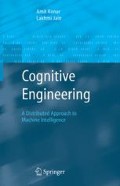Access this chapter
Tax calculation will be finalised at checkout
Purchases are for personal use only
Preview
Unable to display preview. Download preview PDF.
References
Bezdek, J. C., Fuzzy Mathematics in Pattern Classification, Ph.D. Thesis, Applied Mathematics Center, Cornell University, New York Ithaca, 1973.
Biswas, B. and Mukherjee, A. K., “Template matching with fuzzy descriptors,” J. of Inst. of Engineers, 1997.
Carroll, J. M. and Russel, J.A., “Do facial expression signal specific emotion? Judging emotion from the face in context,” Journal of Personality and Social Psychology, vol. 70, no. 2, pp. 205–218, 1996.
Ekman, P. and Friesen, W. V., Unmasking the Face: A Guide to Recognizing Emotions from Facial Clues, Prentice-Hall, Englewood Cliffs, NJ, 1975
Fernandez-Dols, J. M., Wallbotl, H., and Sanhez, F., “Emotion category accessibility and the decoding of emotion from facial expression and context,” Journal of Nonverbal Behavior, vol. 15, 1991.
Izumitani, K., Mikami, T., and Inoue, K., “A model of expression grade for face graphs using fuzzy integral,” System and Control, vol. 28, no. 10, pp. 590–596, 1984.
Kawakami, F., Morishima, S., Yamada, H., and Harashima, H., “Construction of 3-D emotion space using neural network,” Proc. of the 3 rd International Conference on Fuzzy Logic, Neural Nets and Soft Computing, Iizuka, pp. 309–310, 1994.
Klir, G. J. and Yuan, B., Fuzzy Sets and Fuzzy Logic: Theory and Applications, Prentice-Hall, Englwood Cliffs, NJ, 1995.
Kobayashi, H. and Hara, F., “The recognition of basic facial expressions by neural network,” Trans. of the Society of Instrument and Control Engineers, vol. 29, no.1, pp. 112–118, 1993.
Kobayashi, H. and Hara, F., “Measurement of the strength of six basic facial expressions by neural network,” Trans. of the Japan Society of Mechanical Engineers, vol. 59, no. 567, pp. 177–183, 1993.
Kobayashi, H. and Hara, F., “Recognition of mixed facial expressions by neural network”, Trans of the Japan Society of Mechanical Engineers, vol. 59, no. 567, pp. 184–189, 1993.
Konar, A., Computational Intelligence: Principles, Techniques and Applications, Springer-Verlag, Heidelberg, 2005.
Lowery, O., Technical Report of Silent Sounds, Inc., Norcross, GA, 2004.
Ueki, N., Morishima, S., Harashima, H., “Expression analysis/synthesis system based on emotion space constructed by multilayered neural network,” Systems and Computers in Japan, vol. 25, no. 13, 1994.
Uwechue, O. A. and Pandya, S. A., Human Face Recognition Using Third-Order Synthetic Neural Networks, Kluwer Academic Publishers, Boston, 1997.
Vanger, P., Honlinger, R., and Haykin, H., “Applications of synnergetics in decoding facial expressions of emotions,” Proc. of Int. Workshop on Automatic Face and Gesture Recognition, Zurich, pp. 24–29, 1995.
Yamada, H., “Visual information for categorizing facial expression of Emotion,” Applied Cognitive Psychology, vol. 7, pp. 257–270, 1993.
Zimmerman, H. J., Fuzzy Set Theory and Its Applications, Kluwer Academic, Dordrecht, The Netherlands, pp. 131–162, 1996.
Rights and permissions
Copyright information
© 2005 Springer-Verlag London Limited
About this chapter
Cite this chapter
(2005). Human Mood Detection and Control: A Cybernetic Approach. In: Cognitive Engineering. Advanced Information and Knowledge Processing. Springer, London. https://doi.org/10.1007/1-84628-234-9_10
Download citation
DOI: https://doi.org/10.1007/1-84628-234-9_10
Publisher Name: Springer, London
Print ISBN: 978-1-85233-975-3
Online ISBN: 978-1-84628-234-8
eBook Packages: Computer ScienceComputer Science (R0)

